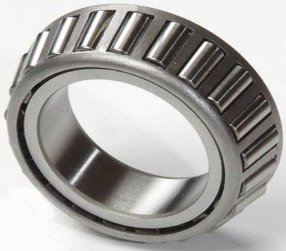Rear Axle Shaft Bearings

Luckily diagnosing axle shaft bearings does not come up very often, because the sounds they make can be mistaken for other drive train problems.
Even a noisy tire with choppy tread can be mistaken for a defective bearing. This article talks about rear axles, seals and bearings. Not to be confused with a standard hub wheel bearing that a rim and tire attach to.
Generally speaking front wheel drive vehicles have rear sealed hub bearings. they often contain ABS wheel speed sensors and can be expensive.
Rear wheel drive vehicles with pumpkin style differentials and solid axles have axle bearings. They are inexpensive but labor intensive to replace and diagnose.
Many vehicles go to the junkyard with the original axle shafts and bearings. If the rear differential is serviced properly and the fluid level is maintained, this will in turn lubricate the bearing.
In this perfect world they should experience long life. The few times I have replaced an axle or their bearings was because of insufficient lubrication.
Periodic inspection of your rear differential and checking fluid level is a good maintenance routine to get into and can save you a lot of trouble as the automobile ages.
Some of the key areas that fluid can leak from are the rear differential pinion seal as well as the axle seals.
When axle seals begin to leak the heavy gear oil can be dispersed onto your rear brake shoes or pads and rotors or drums. This can reduce braking efficiency as well as create noise and possibly a burning odor.
Types of Axle Shaft Bearings
There are three major bearing designs used in cars and trucks. There is a ball type, straight roller and a tapered roller style.
Regardless of the type utilized the main function is to support the vehicle’s weight, reduce rolling friction by allowing the wheel to spin freely.
A visual inspection of the bearing in most cases is not possible until you slide the axle out of the differential housing. In some cases its obvious how the axle is held into the differential housing.
In many Ford applications you will see bolts that hold a flange against the differential tube. Removing these bolts allows the axle to slide out. On GM vehicles it is more common to have the shaft retained in the differential carrier.
On these types of set ups you have to remove the differential cover then remove the pinion shaft. Next push the axles towards the center to reveal and remove a C clip retainer.
With the C shaped clips removed they will easily slide out of the differential housing. When replacement is needed, often the axle bearings are pressed onto the shaft using special equipment and holding fixtures.
Many auto parts stores will provide this service for free if the replacement parts are purchased at the store. You should also replace the axle seals at the same time. The parts store shouldn’t let you walk out the door without new seals.
Diagnosing Bearing Failure
With the axles removed as described above you can perform a visual inspection of the shaft bearings and look for scoring, burn marks or even pitting or chips on the individual rollers.
Most often when lack of lubrication causes bearing failure you can actually see heat damage in the form of bluish or purple marks on the rollers.
When it comes to diagnosing defective parts in any drive-train system a good diagnostic road test should be performed before dis-assembly occurs.
This can often point you towards a suspect part. It may also eliminate other items that can be mistaken for axle shaft bearing noise. Bad axle bearings often make a growling or rumbling sound at highway speeds.
Changing lanes may cause the noisy bearing to either increase or decrease the noise level. An example is if you are in the center lane and you move to the left lane.
Additional weight is put on the right rear. An increase of noise from the right rear during that lane change may indicate an inspection of the right side is necessary.
These types of lane changes and diagnostic methods should only be used in a safe manner. Preferably on a quiet road way with no other traffic around you.
Making drastic lane changes could be considered reckless driving and an accident is highly possible. It wouldn’t make any sense to wreck a perfectly good vehicle just to find out what bearing is noisy.
Give this axle bearing noise page a bookmark or share with friends.
More information about bearing failure and other drivetrain related components can be found on the main manual drive trains page.
Visit the Homepage for YouFixCars.com it’s a fantastic place to learn about what other kinds of automotive information is available here.

